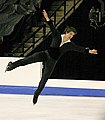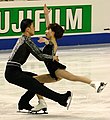Sit spin
| Figure skating element | |
|---|---|
 Jackson Haines (1912), inventor of the sit spin | |
| Element name: | Sit spin |
| Alternative name: | Jackson Haines spin |
| Scoring abbreviation: | SSp |
| Element type: | Spin |
| Named for: | Jackson Haines |
The sit spin (also known as the Jackson Haines spin) was invented by American figure skater Jackson Haines. It has been called "one of the most important spins in skating".[1] The spin is executed on one foot, in a sitting position, with the knee of the skating leg bent in a one-legged crouch position and the free leg held in front, to the side or to the back.[2][3] It is difficult to learn and, requires a great deal of energy, but it has variations that make it more creative and pleasurable to watch.[1][4] When executing the sit spin, a skater's back should be straight and not curved, their hips should be lower than the skating knee, and their free leg should be straight.[2] The best sit spin position minimizes the moment of inertia and keeps the heaviest parts of the body as close to the vertical center of gravity as possible. This position is difficult to maintain, however, so skaters will often collapse into a low sit spin position.[5] The ISU states that if the shin and thigh skater's leg is over approximately 120 degrees, the position is considered an upright or camel spin.[3]
Skaters increase the difficulty of the sit spin in these ways: by bending or straightening their free leg and directing it forward or backward with the thigh of their skating leg parallel to the ice; bending or straightening their free leg and directing it to the side or crossing, extending it behind them, with not more than 90 degrees between the shin of their skating leg and thigh; crossing their free leg behind and touching or not touching their skating leg, with the thigh of their skating leg parallel to the ice; and directing their free leg forward, with not more than 90 degrees between the shin of their skating leg and thigh and their back almost parallel to the ice.[3]
Gallery[]

Flying sit spin
(Jennifer Don)
Deep sit spin with stretched free leg
(Yuzuru Hanyu)
Death drop into a back sit spin
(Ryan Jahnke)
Pair sit spin
(Dan Zhang & Hao Zhang)
Pair sit spin
(Sabina Imaikina & Andrei Novoselov)
Pair side by side sit spins
(Johanna Purdy & Kevin Maguire)
Pair sit and catch-foot layback
(Lubov Iliushechkina & Nodari Maisuradze)
Dance spin (sit and camel)
(Nathalie Pechalat & Fabian Bourzat)
References[]
- ^ a b Petkevich, p. 144
- ^ a b Kestnbaum, Ellyn (2003). Culture on Ice: Figure Skating and Cultural Meaning, p. 280. Middletown, Connecticut: Wesleyan University Press. ISBN 0819566411.
- ^ a b c "Communication No. 2393: Ice Dance". Lausanne, Switzerland: International Skating Union. 6 May 2021. Retrieved 23 June 2021.
- ^ Petkevich, p. 148
- ^ Cabell, Lee and Erica Bateman (2018). "Biomechanics in figure skating". In Jason D. Vescovi and Jaci L. VanHeest (Eds.) The Science of Figure Skating, p. 26. New York: Routledge Publishing. ISBN 978-1-138-22986-0
Works cited[]
- Petkevich, John Misha (1988). Sports Illustrated Figure Skating: Championship Techniques (1st ed.). New York: Sports Illustrated. ISBN 978-1-4616-6440-6. OCLC 815289537.
| Wikimedia Commons has media related to Sit spins. |
- Figure skating elements
- Partial squatting position








